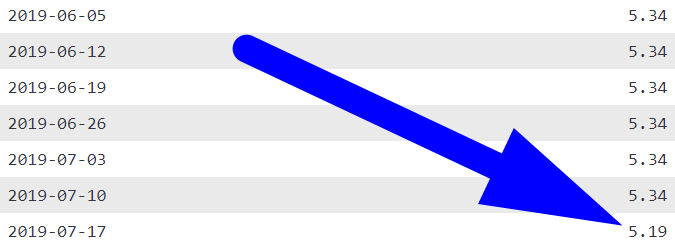The most important rate in the mortgage industry has dropped. Better late than never.
The benchmark posted 5-year fixed rate has fallen from 5.34% to 5.19%.
It’s the first change since May 9, 2018. And it’s the first decrease since Sept. 7, 2016, despite a 106-basis-point nosedive in Canada’s 5-year bond rate since November 8.
Why it Matters
The benchmark rate (a.k.a., stress test rate or “mortgage qualifying rate”) is what federally regulated lenders use to calculate borrowers’ theoretical mortgage payments. A mortgage applicant must then prove they can afford such a payment. In other words, prove that payment doesn’t cause them to exceed the lender’s standard debt-ratio limits.
The rate is purposely inflated to ensure people can afford higher rates in the future.

More Horsepower for Buyers
For a borrower buying a home with 5% down, today’s drop in the stress-test rate means:
- Someone making $50,000 a year can afford $2,800 (1.3%) more home
- Someone making $100,000 a year can afford $5,900 (1.3%) more home
(Assumes no other debts and a 25-year amortization. Figures are rounded and approximate.)

For a borrower buying a home with 20% down, today’s drop in the stress-test rate means:
- Someone making $50,000 a year can afford $4,000 (1.4%) more home
- Someone making $100,000 a year can afford $8,300 (1.4%) more home
(Assumes no other debts and a 30-year amortization. Figures are rounded and approximate.)
In Case You’re Wondering
Almost no one saw this coming due to the stress test rate’s obscure calculation method. So if you’re wondering why it just became easier to qualify for a mortgage, here’s your answer direct from the Bank of Canada:
“There are currently two modes at equal distance from the simple 6-bank average. Therefore, the Bank would use their assets booked in CAD to determine the mode. We use the latest M4 return data released on OSFI’s website to do so. To obtain the value of assets booked in CAD, simply do the subtraction of total assets in foreign currency from total assets in total currency.”
The BoC explains further:
“Prior to July 15th, we were using April’s asset data to determine the typical rate as that was what was published on OSFI’s website. On July 15th, OSFI published the asset data for May, and that is what we used yesterday to determine the 5-year mortgage rate. As a result, the rate changed from 5.34 to 5.19.”
Simple as pie, right?
The Net Effect
Will this buying power stimulus turn the housing market around? Hardly. But it’s an incremental psychological boost for buyers that adds a modicum more support for home prices.
It should also counter, in some small part, what’s been the slowest lending growth in 25 years.

 log in
log in
6 Comments
So I guess that means the qualifying rate might jump back up next month if the Big Six Bank asset distribution reverses. What an absurd way to run things!
Couldn’t have said it better myself Ken.
Someone please explain to me why banks control this idiotic rate??
Nowhere is else is reporting this why
Maybe people are too glued to the Open Championship?
More likely, most don’t know the rate changed and others don’t get why it matters.
Awesome 1.3% more home. Now I can afford that second bedroom….for my dog house.